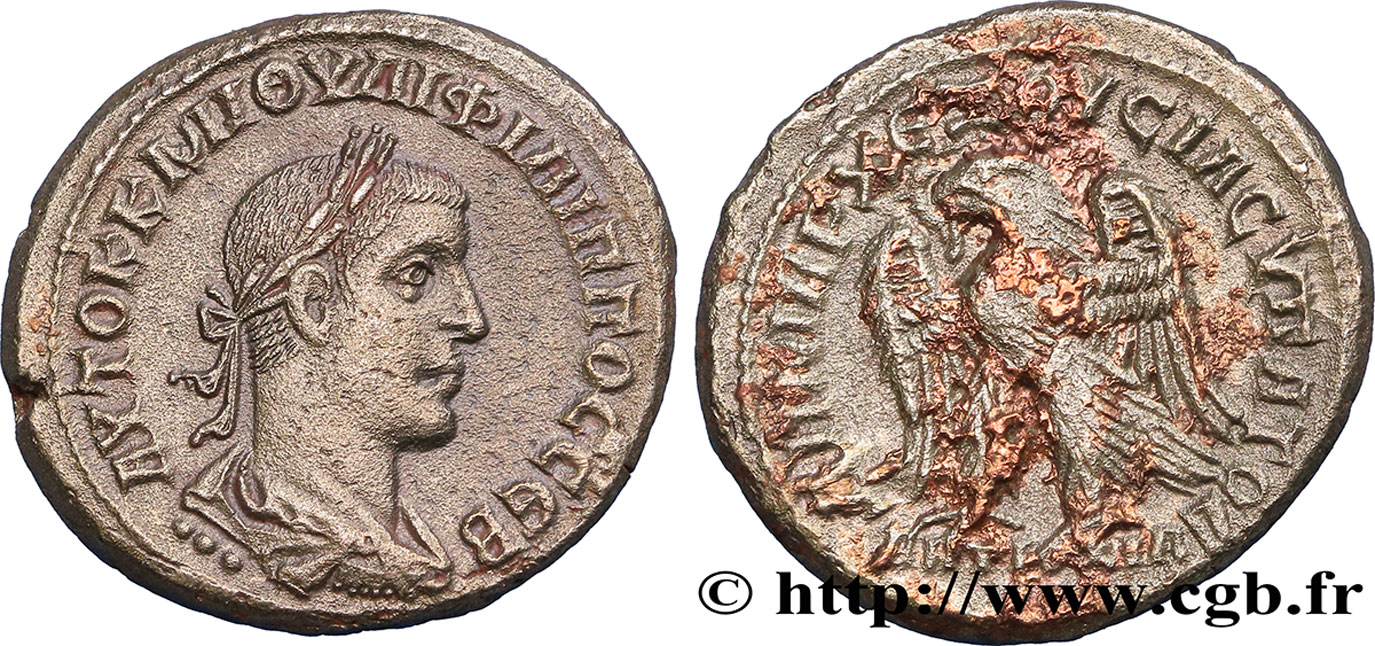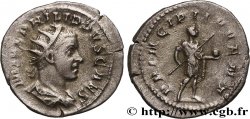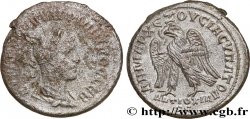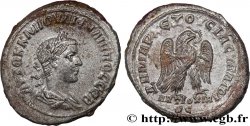E-auction 172-106922 - bpv_154328 - PHILIPPUS II Tétradrachme syro-phénicien
得先注册又得到批准才可以报价。为了报价注册. 客户应该得到公司允许,那种过程需要 48 个小时。别等出售结束那一天才登记。您报价的话等于您赞成买那物品,而且按« 保价 » 证明您接受 cgb.fr 因特网拍卖使用法.
报价时只可以出全数值欧元总额。物品描述也说明销售结束时间,结束后出价都不会生效。 报价命令转达有时变动,等到最后秒钟增加否决的可能会。想多了解的话请注意 因特网拍卖常问
购货人不付费
购货人不付费
| 估算 : | 180 € |
| 价格 : | 46 € |
| 最高出价 : | 47 € |
| 拍卖结束日期 : | 01 August 2016 15:13:30 |
| 竞拍人 : | 10 竞拍人 |
种类 Tétradrachme syro-phénicien
日期: 249
铸币厂名称/城市 Antioche, Syrie, Séleucie et Piérie
材质 billon
直径 28,00 mm
模子方针 1 h.
重量 11,86 g.
稀少度 R2
关于品相的说明
Superbe avers mais des restes de concrétions au revers, sur l’aigle
出版目录中的项代码 :
家谱
Cet exemplaire, qui provient des doubles de la collection McAlee, est le 0492_008 de la base TSP
正面
正面的说明书 Buste lauré, drapé et cuirassé de Philippe II Auguste à droite, vu de trois quarts en arrière (A*2), trois globules sous le buste.
正面铭文 AUTOK K M IOUL FILIPPOS SEB, (Autokratoros Kaisaros Markos Ioulios Filippos Sebastos)
正面的翻译 (L’empereur césar Marc Jules Philippe auguste).
背面
背面的文字 ANTIOXIA / S|C À L’EXERGUE.
背面的说明书 Aigle debout à gauche, les ailes largement déployées, tête à gauche et queue à droite, tenant une couronne feuillée dans son bec.
背面铭文 DHMARC - EX OUSIAS UPATOD
背面的翻译 (Revêtu de la puissance tribunitienne / Consul pour la quatrième fois / avec l’accord du Sénat d’Antioche).
评论
Ces frappes à marques d’officines sont la fin des émissions pour Philippe père et fils, simplement parce que cette même méthode se poursuivra sous le règne de son successeur, Trajan Dèce, alors qu’elle n’existe pas avant le quatrième consulat de Philippe.
Le marquage des officines se fait par points sous le buste, de un à quatre, mais il est possible, au style, de penser que ces émissions comportent aussi une officine sans point. Cette question se réglera, comme tant d’autres, par une reconstitution des chaînes de coins qui montrera, ou non, une série particulière, sans point, du même style de gravure des bustes que les frappes avec points.
Le classement des bustes avec deux points sous la cuirasse, qui se trouvent tant pour le père que pour le fils, dans cette série à officines indiquées, est pratiquement certain. Les arguments en faveur sont la faiblesse des émissions de Philippe père, pour la deuxième officine, avec le buste standard ; on peut donc penser que la production de cette officine a été répartie entre les deux types de bustes alors que celles des autres se concentraient sur des bustes standards, laurés, drapés et cuirassés à droite.
Pour le fils, les émissions avec deux points sous la cuirasse viennent peut-être compléter les émissions de cette officine à buste standard car, là, ce sont les frappes avec aigle à droite qui sont inconnues et n’existent peut-être pas.
Ces émissions sont fort rares et précèdent certainement de très peu la chute des Philippe. On ne peut pas déterminer actuellement le motif de cette réorganisation, peut-être à réfléchir en comparaison avec les frappes d’antoniniens.
Curieusement, elles sont peu présentes en musées, ou d’acquisitions récentes. Aucun exemplaire n’est référencé dans le BMC et il semble que sans les trouvailles de Doura, l’émission serait restée ignorée.
Dès que Philippe II est proclamé auguste, il utilise toujours les titres de son père au revers mais encore adopte sa titulature de droit. Les collectionneurs débutants ont d’ailleurs des difficultés à distinguer le père du fils ; la règle est simple : le père a toujours une ride qui barre le front, le fils toujours un front lisse.
On note que les sigma sont gravés en C.
Dans la base TSP maintenue par Michel Prieur, treize exemplaires sont maintenant répertoriés pour ce type, dont plusieurs en musées, Jerusalem (provenant de la trouvaille de Capharnaum) British Museum (provenant de la trouvaille de Pregliasco N° 49 Numismatic Chronicle 1991 p 33 pl 12), Yale et Berne (provenant de la collection Righetti).
These strikes with office marks are the end of the issues for Philip father and son, simply because this same method will continue under the reign of his successor, Trajan Decius, whereas it does not exist before the fourth consulate of Philip.
The marking of the pharmacies is done by points under the bust, from one to four, but it is possible, from the style, to think that these emissions also include a pharmacy without points. This question will be resolved, like so many others, by a reconstruction of the chains of dies which will show, or not, a particular series, without point, of the same style of engraving of the busts as the strikes with points.
The classification of the busts with two points under the armor, which are found for both the father and the son, in this series with indicated offices, is practically certain. The arguments in favor are the weakness of the issues of Philippe père, for the second workshop, with the standard bust; we can therefore think that the production of this workshop was divided between the two types of busts while those of the others concentrated on standard busts, laureates, draped and cuirassed on the right.
For the son, the issues with two points under the armor perhaps complement the issues of this office with a standard bust because, there, it is the strikes with an eagle on the right which are unknown and perhaps do not exist..
These broadcasts are very rare and certainly precede the fall of the Philippes by a very short time.. The reason for this reorganization cannot be determined at present, perhaps in comparison with the Antoninian strikes..
Curiously, they are rarely found in museums, or are recent acquisitions.. No copy is referenced in the BMC and it seems that without Doura's finds, the broadcast would have remained unknown..
As soon as Philip II was proclaimed Augustus, he still used his father's titles on the reverse but also adopted his title by right.. Beginner collectors have difficulty distinguishing the father from the son; the rule is simple: the father always has a wrinkle across his forehead, the son always has a smooth forehead..
Note that the sigmas are engraved in C.
In the TSP database maintained by Michel Prieur, thirteen examples are now listed for this type, including several in museums, Jerusalem (from the Capharnaum find) British Museum (from the Pregliasco find No. 49 Numismatic Chronicle 1991 p 33 pl 12), Yale and Berne (from the Righetti collection)
Le marquage des officines se fait par points sous le buste, de un à quatre, mais il est possible, au style, de penser que ces émissions comportent aussi une officine sans point. Cette question se réglera, comme tant d’autres, par une reconstitution des chaînes de coins qui montrera, ou non, une série particulière, sans point, du même style de gravure des bustes que les frappes avec points.
Le classement des bustes avec deux points sous la cuirasse, qui se trouvent tant pour le père que pour le fils, dans cette série à officines indiquées, est pratiquement certain. Les arguments en faveur sont la faiblesse des émissions de Philippe père, pour la deuxième officine, avec le buste standard ; on peut donc penser que la production de cette officine a été répartie entre les deux types de bustes alors que celles des autres se concentraient sur des bustes standards, laurés, drapés et cuirassés à droite.
Pour le fils, les émissions avec deux points sous la cuirasse viennent peut-être compléter les émissions de cette officine à buste standard car, là, ce sont les frappes avec aigle à droite qui sont inconnues et n’existent peut-être pas.
Ces émissions sont fort rares et précèdent certainement de très peu la chute des Philippe. On ne peut pas déterminer actuellement le motif de cette réorganisation, peut-être à réfléchir en comparaison avec les frappes d’antoniniens.
Curieusement, elles sont peu présentes en musées, ou d’acquisitions récentes. Aucun exemplaire n’est référencé dans le BMC et il semble que sans les trouvailles de Doura, l’émission serait restée ignorée.
Dès que Philippe II est proclamé auguste, il utilise toujours les titres de son père au revers mais encore adopte sa titulature de droit. Les collectionneurs débutants ont d’ailleurs des difficultés à distinguer le père du fils ; la règle est simple : le père a toujours une ride qui barre le front, le fils toujours un front lisse.
On note que les sigma sont gravés en C.
Dans la base TSP maintenue par Michel Prieur, treize exemplaires sont maintenant répertoriés pour ce type, dont plusieurs en musées, Jerusalem (provenant de la trouvaille de Capharnaum) British Museum (provenant de la trouvaille de Pregliasco N° 49 Numismatic Chronicle 1991 p 33 pl 12), Yale et Berne (provenant de la collection Righetti).
These strikes with office marks are the end of the issues for Philip father and son, simply because this same method will continue under the reign of his successor, Trajan Decius, whereas it does not exist before the fourth consulate of Philip.
The marking of the pharmacies is done by points under the bust, from one to four, but it is possible, from the style, to think that these emissions also include a pharmacy without points. This question will be resolved, like so many others, by a reconstruction of the chains of dies which will show, or not, a particular series, without point, of the same style of engraving of the busts as the strikes with points.
The classification of the busts with two points under the armor, which are found for both the father and the son, in this series with indicated offices, is practically certain. The arguments in favor are the weakness of the issues of Philippe père, for the second workshop, with the standard bust; we can therefore think that the production of this workshop was divided between the two types of busts while those of the others concentrated on standard busts, laureates, draped and cuirassed on the right.
For the son, the issues with two points under the armor perhaps complement the issues of this office with a standard bust because, there, it is the strikes with an eagle on the right which are unknown and perhaps do not exist..
These broadcasts are very rare and certainly precede the fall of the Philippes by a very short time.. The reason for this reorganization cannot be determined at present, perhaps in comparison with the Antoninian strikes..
Curiously, they are rarely found in museums, or are recent acquisitions.. No copy is referenced in the BMC and it seems that without Doura's finds, the broadcast would have remained unknown..
As soon as Philip II was proclaimed Augustus, he still used his father's titles on the reverse but also adopted his title by right.. Beginner collectors have difficulty distinguishing the father from the son; the rule is simple: the father always has a wrinkle across his forehead, the son always has a smooth forehead..
Note that the sigmas are engraved in C.
In the TSP database maintained by Michel Prieur, thirteen examples are now listed for this type, including several in museums, Jerusalem (from the Capharnaum find) British Museum (from the Pregliasco find No. 49 Numismatic Chronicle 1991 p 33 pl 12), Yale and Berne (from the Righetti collection)








 对产品描述纠错
对产品描述纠错 打印
打印 分享我的选择
分享我的选择 提问
提问 Consign / sell
Consign / sell
 产品介绍
产品介绍









